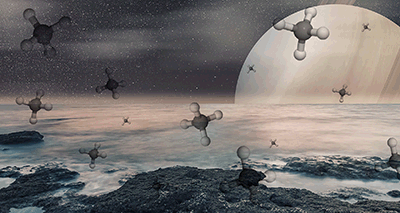Helping scientists better understand the methane-rich outer planets

An international team, including ILL scientists, have used neutron scattering to study the behaviour of dense supercritical methane. Their results could help to better model the interiors of methane-rich outer planets of our solar system.
“Methane is one of the most abundant molecules in the Universe and there’s no doubt it is a major component in our solar system, especially on planets further out from the Sun than Mars,” explains Umbertoluca Ranieri, former ILL PhD student and now a postdoctoral researcher at Sapienza University in Rome. “With data at hand coming from the most recent space missions, scientists are modelling the interiors of those planetary bodies, and our study provides new clues for that modelling."
The team studied methane at room temperature and pressures from 0.1 GPa, roughly the pressure at the bottom of the ocean, up to 1.4 GPa, which is comparable to the pressure at the junction between the Earth’s crust and the mantle. They were interested in looking at how methane behaves near its ‘freezing pressure’, where it crystallises. This pressure, of approximately 1.4 GPa, is equivalent to stacking fourteen walruses (14 tonnes!) onto your thumbnail.
To generate such high pressures in a laboratory, they used two different devices: a continuously loaded gas pressure cell and a so-called Paris-Edinburgh cell. “The measurements were very challenging and there was no room for mistakes because methane is flammable and explosive, and we were operating in a reactor guide hall,” Dr. Ranieri explains. “ILL was the only place to carry out such experiments."
“The physical-chemical properties of molecular fluids, such as methane, in the dense supercritical state are largely unknown and can be surprisingly different from everything we are used to in our daily life,” says Dr. Ranieri. “The latest technical advances in high-pressure technology provided the fantastic opportunity to perform quasi-elastic neutron scattering measurements of methane in this poorly-investigated state.” The team used these measurements to investigate how methane molecules diffuse. Their study is the first to look at the microscopic diffusion of methane in a dense supercritical state.
The scientists were surprised to find that the diffusion didn’t slow down as quickly as they expected with increasing pressure. “We found a different behaviour than that predicted by standard models of simple fluids,” says Dr. Ranieri. “This means caution is always needed when extrapolating properties and physical behaviours from a different thermodynamic regime– even for supposedly ‘simple’ molecules like methane.”
The team of researchers is now working to extend the available dataset in pressure and in temperature. In addition to contributing to a more profound understanding of planetary interiors, this knowledge will also help us to tackle important issues involving compressed supercritical fluids in the food, petrochemical, nuclear waste and pharmaceutical industries, and could possibly have applications for understanding how pressure waves generated by earthquakes travel within the Earth.
The study was published in March 2021 in Nature Communications and has been selected as an Editors’ Highlight.
ILL instrument: the IN6-SHARP spectrometer
